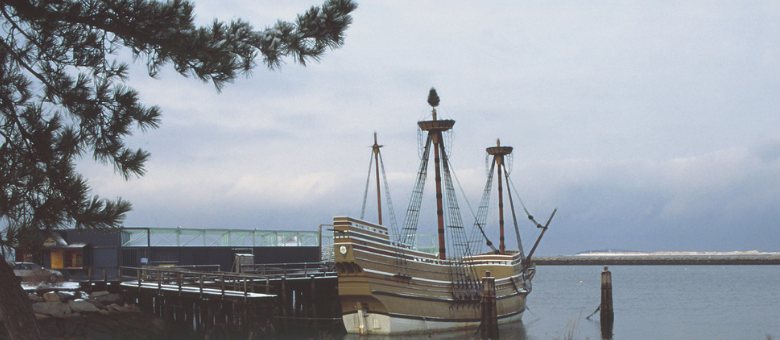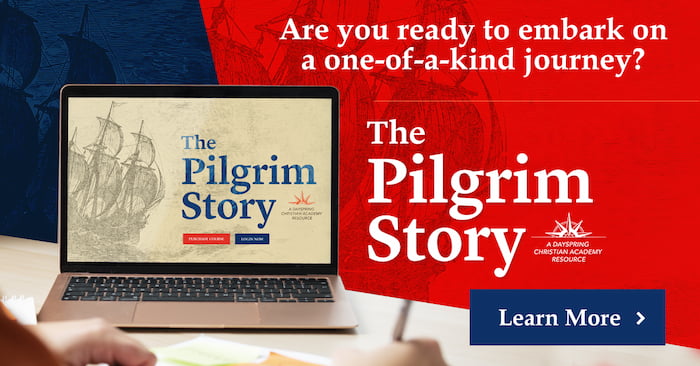Before Civil War, battlefields ran red with the blood of countrymen to end the blight of slavery, before our Founding Fathers broke the yoke of tyranny in the American Revolution and sought liberty for We the People, a brave band of Christians known as the Pilgrims humbly sailed into freedom in the New World aboard the Mayflower.
The roots of our constitutional republic may be traced to the sacrifice of the Pilgrims aboard that ship and the 51 who survived the treacherous first winter in Plymouth, Mass., after they came ashore on November 11, 1620 – 400 years ago.
The Real Story of the Pilgrims
The Significance of 400 Years
In the Bible, it appears that 400 years bears some significance. Consider the Israelites bound as Egyptian slaves for 400 years (1900 to 1500 B.C.). Then, in what is now called the “Hebrew Republic,” the nation of Israel found freedom under God’s law from 1450 to 1050 B.C.1

Pilgrim Pastor John Robinson wrote a letter to the Pilgrims that was read to all before their departure. It encouraged them “to become a body politic, administering among yourselves civil government” and reminded them that they “are furnished with persons of now special eminence above the rest, from whom you will elect some to the office of government.” In his journal, Bradford says that the passengers chose governors and two or three assistants to take charge of the people on the way. 1
According to E.W. Bullinger in his 1921 publication of Number in Scripture: It’s Supernatural Design and Spiritual Significance, in the Bible, 400 years is a symbol of expectation and hope. “In essence, it is a kingdom number representing at least ten generations or eight cycles of the jubilee year of fifty and reveals, over time, the fruit of the ideas embraced by a people that bring either liberty or slavery to a nation” Bullinger said.2
Bullinger’s words read as a warning for our country today. Not only did Pilgrim Governor William Bradford risk his life to light the flame of liberty for what would become America, his tombstone issues an indelible reminder to us: “What our fathers with so much difficulty attained, do not basely relinquish.”
A First-Hand Account of the Pilgrims
With history now being rewritten or even erased, it is important to note that the story of the Pilgrims has been preserved in a first-hand account.
“We have a national treasure, and it is called Of Plimoth Plantation,” said Dayspring Christian Academy Upper School principal Dan Stone, who taught Rudiments of America’s Christian History and Government to ninth-grade students for 15 years and led many trips to study the seeds of our nation’s beginnings in Boston and Plymouth. “This ‘book’ is written by William Bradford, and it is his personal journal. Bradford was probably the Pilgrim of all Pilgrims if you will. He was governor of the colony for the first 33 years, and his journal is the primary source for the Pilgrim story. In class, we also read from (Pilgrim) Edward Winslow, who had several much shorter journals. Bradford’s journal is quite lengthy. He wrote it over a number of years, and that’s where we get most of the information on the Pilgrims.”
At Dayspring Christian Academy, students learn through the Principle Approach method of education to study history from original or primary sources. With the preservation of Bradford’s journal, the Pilgrim story can be learned from a first-hand source – from one who lived every minute of their harrowing journey.
The Pilgrim Story
To tell the Pilgrim story, Stone and colleague Mary Stauffer were interviewed. Stauffer has led more than 30 trips to Plymouth to study the Pilgrims as part of the third-grade curriculum she taught for many years at Dayspring Christian Academy. After years of studying and teaching about the Pilgrims, Stauffer and Stone’s expertise runs deep on the subject. Dayspring also shares this story each November through a community education program called “Thanksgiving Exposed.” Guests are led through a series of scenes that tells how the Pilgrims brought the Gospel to the New World. Dayspring students benefit from the expertise of these teachers and grow to appreciate God’s hand in history and how He used people and nations to move the Gospel westward.
Who Were the Pilgrims?
AWAKEN: Who were the Pilgrims?
STAUFFER: The Pilgrims that we are talking about are a small group of people who started as a Christian congregation in Scrooby, England, in the early 1600s. The Pilgrims left England to go to Holland, and eventually, the Pilgrims came to the New World. They were the firstcomers.
AWAKEN: What was happening in England that caused the Pilgrims to leave that country and go to Holland?
STAUFFER: In the early 1600s, the Church of England was controlled by the government and specifically by King James. However, the church became corrupt when King Henry VIII divorced himself from the Roman Catholic Church and established himself as head of the Church of England.
At the time, it was against the law to own a copy of the Word of God, but many people had indeed received a copy called the Geneva Bible. As they began to read it, (William) Bradford said that “many had their hearts enlightened by the Word of God, had their ignorance and sins discovered unto them, and by God’s grace began to reform their lives.”
This group of believers began to realize that the Church of England was corrupt and that one did not need a bishop or a pope, or someone above you to access God. Scripture says that our eternal salvation was not earned by things that we did or the money that we gave. The Pilgrims saw that God’s Word says that salvation is the gift of free grace through Jesus Christ and realized they could not serve the corrupt church.
AWAKEN: But weren’t the church and the government both under the authority of the king?
STAUFFER: Yes, this caused them to realize that they also could not serve the government because the church and the government were one. The king was the head of the church. The king felt God talked to the king and the king only. The common man was not able to have access to God, and so when you said you were leaving the Church of England, it wasn’t like you were just going to go to another denomination or a church across the street. It was tantamount to treason when this group of people said they were rejecting the Church of England.
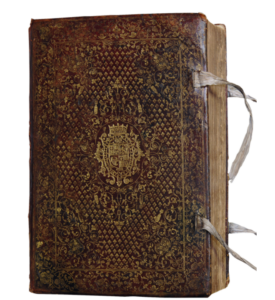
When King James wanted to break away from the Catholic Church, he promoted people being able to read the Bible in their own language.
STONE: In Bradford’s journal, he says that they decided to reform without “tarrying for any.” They had the Bible in their own language. When King James wanted to break away from the Catholic Church, he promoted people being able to read the Bible in their own language. Then when people actually began to see what Scripture said, that is when they realized not only is the Catholic Church corrupt, the Church of England is corrupt as well.
There was a group of Puritans who rose to try to reform the church from within. But these Pilgrims, who were first called separatists, realized the Church of England in its current state could not be reformed from within, and that’s when they began to meet in secret and practice Christianity, as Bradford said, according to the dictates of their conscience.
STAUFFER: As they began to understand God’s Word, they realized they were not able to stay within the church and that they needed to separate themselves to worship God and to follow God according to the Scriptures.
AWAKEN: Was it a problem for people trying to separate from the Church of England?
STAUFFER: After this decision to leave the Church of England and worship on their own, Bradford says they were watched day and night. The king’s guard sought to catch them worshiping in secret, and if caught, their penalty could be prison or worse. In England, they would be persecuted, as in not being able to work. People wouldn’t play with their children. (Those worshiping in secret) would be put in prison.
AWAKEN: What did the Pilgrims decide to do?
STONE: After scorning, harassment, and imprisonment, this small congregation decided to flee England. At the time, Holland was well known for its religious tolerance, and so they decided to try and make a life for themselves in a country where they could freely worship.
The Decision to Leave Holland
AWAKEN: Where in Holland did they settle?
STAUFFER: After fleeing to Holland, the Pilgrims settled in Leiden for 12 years.
AWAKEN: What was life like for them in Holland?
STAUFFER: They were known for great character, for being excellent workers, and for being honest people. But they had a difficult time figuring out how to make a living and took low-level jobs. They were gentleman farmers, so they didn’t bring a lot of skills. Even their children were working in ribbon factories to help make ends meet for the family. They said the children were getting bent over with age before their time. Some of the children were beginning to take on characteristics of Holland citizens. They very much loved England and wanted the children to be raised as Englishmen, not as citizens of Holland.
STONE: While it was true that Holland was a very tolerant place, this meant that they were tolerant not just toward religious things but also tolerant to a lot of other things. Bradford said, “The children began to fall into the sin and licentiousness of the place.” So they were beginning to lose their children.
This is one of the parts of the story that resonates with me the most. Stop me if this sounds familiar. You live in a country that is very tolerant, that’s very open. There is religious freedom – and that is a wonderful blessing – but also, with that comes the freedom not to believe or the freedom to believe different things and young people can be easily lured away by the temptations of the world. We, as Christians living in America today, can easily identify with the concerns these people had for their children.
After 12 years in Holland, they began to discuss the possibility of leaving.
AWAKEN: Where did the idea come from to take the bold step of leaving all they knew and crossing a vast ocean to the unknown wilderness of the New World?
STONE: Perhaps due to their tribulation, they were a united and courageous people who began to consider their next move. It was the age of exploration. Colonialism was the thing that European powers were doing at the time, and so it was kind of a natural way of thinking. In some respects, there was this New World being discovered, and there were all kinds of opportunities over there. Going back to England wasn’t an option. Staying in Holland wasn’t an option. And so, the talk of America became a possibility.
STAUFFER: They had thoughts on Guyana as well, which was a very warm climate. Other countries around them were just as dangerous for Christians, (and) people were being murdered for their faith. They really didn’t have a whole lot of options as far as where to go. Of course, the decision was not made lightly. The Pilgrims were fearful of getting sick, fearful of dying. Many people were lost in voyages to the New World.
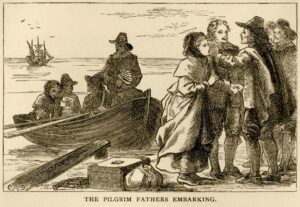
The Pilgrim Fathers were a group of English Puritans who settled at Plymouth in 1620 to advance the Gospel of the kingdom of Christ in those remote parts of the world.
Bradford, however, had an answer to any pending danger. In one of his most famous quotes, he said, “It is required that all great and honorable actions are accompanied by great difficulties, and both must be met and overcome with answerable courageous.”
Regardless of what would befall them on their journey, they believed that whether they lost their lives or not, they were doing what they believed God had called them to do – and that was worthy and honorable.
AWAKEN: It is important to understand why the Pilgrims came to the New World. According to Bradford, why did they make the journey?
STONE: When I teach this, I have my students memorize why the Pilgrims chose to go to the New World. One of those reasons that Bradford gives is that they had “a great hope and inward zeal of laying some good foundation, or at least to make some way thereunto, for the propagating and advancing the Gospel of the kingdom of Christ in those remote parts of the world.”
They had a chance to start a new life; they had a chance for economic opportunity. But they also recognized that there were native peoples living in the New World who needed to hear the Gospel. And that is certainly something they could be a part of if they could take this journey. Part of the reason they were going was a missionary purpose.
The Mayflower Sets Sail
AWAKEN: Who boarded the Mayflower?
STONE: While in Holland, the small group had swelled to a congregation of 300 that was led by Pastor John Robinson, who had become a famous professor and lecturer at a university in Leiden. However, only a small number set out on this voyage.
STAUFFER: Altogether, there were about 102 people who ended up making the journey. Those making the trip ranged from a child of about 1 to a 64-year-old man. They very much came as families wanting to make a way for themselves in the New World.
AWAKEN: Who were the others on the ship?
STAUFFER: There was the Holland congregation that ended up being about half of the 102 and the rest coming from England. What the Pilgrims did to fund the voyage was to indenture themselves to a group of English merchants. The merchants funded the voyage and chartered the Mayflower to carry these people.
AWAKEN: Tell a little about the Mayflower and the other ship that was supposed to make the voyage.
STAUFFER: The Mayflower was a wine ship that only traveled the English Channel. But they hired out the Mayflower for the trip, and the Pilgrims bought a ship called the Speedwell. The plan was for the Speedwell and the Mayflower to go. The Speedwell was then supposed to stay with the Pilgrims while the Mayflower returned. The Merchant Adventurers were the ones who funded the voyage. Bradford wrote in his journal a good bit about the conflict between the Pilgrims and the merchants. In some ways, they were swindled. They were supposed to work four days of the week for the merchants and two days for themselves, and that got changed to have to work all six days of the week for the merchants. But another part of that was that some people who were going to be joining them on their voyage were not part of their congregation. These others from England were presumably Christian but probably more of the Church of England and not the Holland congregation.
AWAKEN: Two ships left. One made it. What happened?
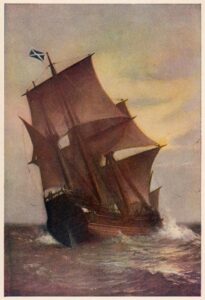
The passengers endured the stormy seas of the North Atlantic as they made their way to the New World.
STAUFFER: The Pilgrims set out on the Speedwell from Leiden. They were meeting up with the Mayflower in England, and when they set sail for the New World, they found out that the Speedwell was leaky, so they pulled into port and had the ship repaired. They set out again, and it began to leak again, and they pulled into port. The third time they decided to abandon the ship.
Meanwhile, time is ticking away. They ended up leaving in September, which is late for anyone to sail the north seas because it’s a stormy season. They had to figure out who was going to go. They couldn’t take all of the people from the Speedwell on the Mayflower. The Mayflower was already packed full of goods, full of people. Some decided it was not what they were looking to do. Some were too fearful to get back on the ship. They also left people behind who were too frail and who they felt wouldn’t be able to make the trip. About 50 from the Scrooby congregation and about 50 who were called “strangers” set sail from Plymouth, England.
AWAKEN: What were the conditions aboard the Mayflower?
STAUFFER: The journey should have taken about 33 days. It took them 66 days because they encountered storms more than half the time. Ships weren’t really used for transporting people at that time but for transporting goods. The sailors pretty much considered them to be cargo rather than people that they were transporting. They kept them between decks in an area that is normally about five feet high. There wasn’t a lot of light coming in. They had to seal it off because the ship was rolling a lot at sea, and they didn’t want water to get in. There was probably not a lot of fresh air coming in for most of the trip. It was dark, dank, and smelly. They had animals down below with them – chickens, pigs, goats – and using the bathroom would have been using the community chamber pot that would have been emptied once or twice a day by the sailors. Another reason for these sailors to really hate these people.
STONE: You are talking about 102 people and all of their goods and any number of animals on about the size of a volleyball court if you can imagine that. And imagine a lot of them being seasick. The smells, the lack of fresh air, no light.
The Mayflower Compact
AWAKEN: When they arrived in America, what happened?
STAUFFER: When they arrived in the New World and saw the land, they realized they had been blown north of their destination by the storms. Their patent had been for the northern parts of Virginia where the mouth of the Hudson “doth flow into the sea,” which is about New York City today, but they first saw land at Provincetown, Mass. They were way off where they needed to be. They made several attempts to sail south to honor the patent, but they ended up in dangerous waters off the coast of Massachusetts. It’s called Pollock Rip, where there are more shipwrecks than any place else on the Eastern Seaboard. By God’s providence, a wind came off the land and blew them back out to safety. They sailed back up to Provincetown and realized then that they were not going to be in the area for which they held a patent.
So, we have two groups of people. We have the Scrooby congregation that had been in Holland, and we also have the strangers who said they were going to use their liberty to do as they chose in the New World because no one had the power to command them without a patent. At that point, the Scrooby congregation got together and decided that something needed to be done in order to prevent that mutiny.
AWAKEN: They were still offshore when this happened, and the Pilgrims realized they needed something to hold them together. What did they do?
STONE: We don’t know a lot of reasoning that is used between the Pilgrims and the strangers to get them to resolve this difference. Bradford doesn’t tell us. We don’t get any inside scoop as to the debate. We just know that at some level, they were able to reason together and say, “We need to come up with something that we can all agree to.” and what we get is the Mayflower Compact, which really is just a philosophical document.
It is, however, interesting to note that some of the language of the Mayflower Compact bears a resemblance to a sermon that the Pilgrims’ pastor in Holland, John Robinson, gave before they departed for the New World. When the Pilgrims came into hardship and disagreement, they found a way to establish unity as a civil body politic, and it’s easy then to see the teaching from their pastor is really what guided them in that thinking. At Dayspring, we talk about Christian self-government, and this is really where we can see a historical and biblical example of that.
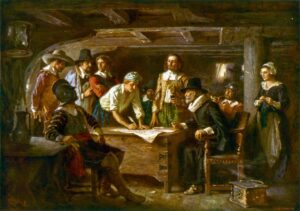
The Mayflower Compact reads: In the name of God, Amen. We whose names are under-written, the loyal subjects of our dread sovereign Lord, King James, by the grace of God, of Great Britain, France, and Ireland King, Defender of the Faith, etc. Having undertaken, for the glory of God, and advancement of the Christian faith, and honor of our King and Country, a voyage to plant the first colony in the northern parts of Virginia, do by these presents solemnly and mutually, in the presence of God, and one of another, covenant and combine our selves together into a civil body politic, for our better ordering and preservation and furtherance of the ends aforesaid; and by virtue hereof to enact, constitute, and frame such just and equal laws, ordinances, acts, constitutions and offices, from time to time, as shall be thought most meet and convenient for the general good of the Colony, unto which we promise all due submission and obedience. In witness whereof we have hereunder subscribed our names at Cape Cod, the eleventh of November [New Style, November 21], in the year of the reign of our sovereign lord, King James, of England, France, and Ireland, the eighteenth, and of Scotland the fifty-fourth. Anno Dom. 1620.
AWAKEN: Would we have any record of the Mayflower Compact without William Bradford’s journal?
STONE: There is no other copy of the Mayflower Compact in existence. It is simply what Bradford copied into his journal. But every single one of the men on board the Mayflower signed the Mayflower Compact, and it held them together. As the colony progressed and they began to put together a government where they were electing a governor and enacting laws, the Compact is something that everyone was able to point to and say, “We all agreed to this, and we are going to abide by it.”
AWAKEN: The Mayflower Compact has a compelling introduction. What does it say as far as why the journey was made?
STAUFFER: It starts, “Having undertaken for the Glory of God and advancement of the Christian Faith and Honour of our King and Country, a Voyage to plant the First Colony in the Northern Parts of Virginia.” They outline three reasons why they are there, which are very honorable reasons. They are not there to get land. They are not there to get money. Bradford very plainly sets out in the Compact the purposes of establishing this first colony in the northern parts of Virginia.
AWAKEN: What happened after the Compact was signed?
STONE: After the Compact is agreed upon, they realize they are going to settle in New England. Their first priority is to find a freshwater source and a suitable piece of land to establish a plantation. The men leave the Mayflower on a secondary boat and explore what we know today as Cape Cod.
The Desperate Condition of the Pilgrims
AWAKEN: How did the Pilgrims fare on their voyage?
STONE: When they arrived, they were in very bad shape. They arrived at the beginning of winter. So any harvesting of crops would be over for the year. They were looking at the winter ahead of them with only the food aboard the Mayflower (and what they could hunt) until they could get through the next harvest.
STAUFFER: Some of the food that they started with ended up being sold to the Merchant Adventurers to fulfill their new agreement. When the Merchant Adventurers got to the Mayflower, they changed the agreement, and the Pilgrims had to pay taxes and other fees, so they started selling off their supplies. They didn’t have everything they started with.
One of the quotes from Bradford that just touches my heart and reminds us of what it was like when they got to the New World was this: “But here I cannot but stay and make a pause, and stand half amazed at this poor people’s present condition; and so I think will the reader, too, when he well considers the same. Being thus passed the vast ocean and a sea of troubles before in their preparation … they had now no friends to welcome them nor inns to entertain or refresh their weather-beaten bodies; no houses or much less towns to repair to, to seek for succor.”
He goes on to say, “What can now sustain us but the Spirit of God and His grace?” They are very much dependent on God.
God’s Providence
AWAKEN: This is one of those places where you can see God’s hand in history. The Lord pulled them up to a place in New England that had been deserted. Something very distinct happened that there were no Native Americans in this area where they landed at that time. What happened?
STONE: (What is now) the town of Plymouth, Mass., was a Native American village called Patuxet, and it was home to the Wampanoag Indians. However, they had been decimated by a plague, likely smallpox. The land the Pilgrims found was a shallow harbor. There was a freshwater brook that ran through the town that was a dependable freshwater source for them, and the land had been cleared. There was no one living there. This is where they decided to make their plantation. As time went on, they encountered the Native Americans, and one of their first priorities once that happened was to make a peace treaty with them.
AWAKEN: It’s November, and the weather in New England was about to take a turn toward winter. How did the Pilgrims survive?
STONE: The short answer is half of them did not survive. The first winter was very rough. They had to stay on the ship for a period of time. There was no shelter for them to go to on land. Their priority was to build shelters for people to begin offloading from the Mayflower. In the midst of that, people began to get very sick. Since they were still living on board the Mayflower, the captain wanted the sick people to get off the ship. The first structure they built was to house sick people.
STAUFFER: I think it is accurate that some people got sick and never made it off the Mayflower. Also, the men who were trying to build houses got very sick as well. So many of them were trying to work while they were desperately ill.
STONE: Bradford says at some points, there were only six or seven people who could care for the sick. All of their efforts went from trying to build houses to just surviving and trying to care for the sick. He said:
And of these, in the time of most distress, there were but six or seven sound persons who, to their great commendations, be it spoken, spared no pains night nor day, but with an abundance of toil and hazard of their own health, fetched them wood, made their fires, dressed them meat, made their beds, washed their loathsome clothes, clothed and unclothed them: in a word, did all the homely and necessary offices for them which dainty and queasy stomachs cannot endure hearing named; and all this willingly and cheerfully, without any grudging in the least, showing herein their true love unto their friends and brethren; a rare example and worthy to be remembered. Two of these seven were Mr. William Brewster, their reverend elder, and Myles Standish, their captain and military commander, to whom myself and many others were much beholden in our low and sick condition. And yet the Lord so upheld these persons as in this general calamity they were not at all infected either with sickness or lameness.
One of my favorite parts of the story is when the Mayflower passengers begin to get sick, and the captain wants them off the boat as quickly as possible. Then something happens when the crew begins to get sick, and they beg the Pilgrims, who are healthy, to care for the sick crewmen. And the Pilgrims do. It’s one of the real testaments to their Christian character. These crew members treated them very poorly, and when the crew members get sick, the Pilgrims say, “Yes, we will take care of you.”
STAUFFER: At that point in the depth of winter in January and February, there were two or three dying every day. They were very concerned about the native population in the area. This was before the peace treaty. So, they would bury their dead at night in unmarked graves covered over so that (anyone watching from a distance) would not know how quickly they were dying. If there was a sign of attack, they would take the sick and prop them up against a fence post so that natives could see that there were faces there even though they weren’t well enough to protect and defend.
AWAKEN: The Pilgrims made a tremendous sacrifice. In fact, there is a sarcophagus in Plymouth today that contains the bones of all of the people who died that winter. How did they set all aside to make this incredible voyage?
STONE: There’s no shortage of times when they could easily have said, “Maybe God is closing this door. Maybe this isn’t God’s will.” Consider the swindling of the Merchant Adventurers. The leaking of the Speedwell. The late departure from England. The arrival in winter. The fact that half of them died. However, when the Mayflower returned to England in April of 1621, not a single person from the strangers or the Pilgrims got on the ship to sail back to England. Every single one of them stayed in the New World. They stayed the course. I’ll never get over that. It’s astounding.
The Pilgrims Encounter Native Americans
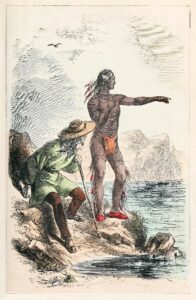
The Pilgrims enjoyed a friendly and mutually beneficial relationship with the Native Americans. Samoset and Squanto were two who were instrumental in the Pilgrims’ survival.
AWAKEN: Who were the first Native Americans they initially met, and how did they help the Pilgrims?
STAUFFER: We have to remember that the Pilgrims were gentleman farmers. They had few skills. They didn’t know how to farm this land. It’s not England. It was sandy land. The crops grew differently. Many things they grew in England were not going to take off in this soil. They needed someone to teach them where to hunt. How to hunt. How to farm the land. Someone to interpret and talk to the other natives in the area. They very much wanted to be friends with the natives. Bradford saw the natives as lost brothers and sisters in Christ. He figured that if the Pilgrims were friendly toward the Native Americans, surely they would be friendly toward them in return. They realized that they were going to need help to make alliances with people who were in the area and with hunting and farming.
STONE: Samoset was the first Native American they met. He spoke very little English when he came to them in the spring as they began to recover, work on houses again, and find food. It was Samoset who told them about one called Squanto, who spoke even better English. They meet Squanto, and his story is incredible. He was kidnapped by English traders. He spent several years in England and learned the English language fairly well. He was a slave to the fishermen who took him, lived as a servant in England, and eventually escaped and came back to the New World. Bradford calls him a “special instrument of God for their good.” Squanto then began to serve as their translator and helped to facilitate for them the meeting with Massasoit, who was the Native American chief of these parts. Squanto went to live with the Pilgrims for the next couple of years and eventually became a Christian.
Hobomok is another Native American. About three years or so into the plantation, there was a drought, and Hobomok came to live with the Pilgrims. Bradford called all of the people together to say, “We’ve been too prideful. We’ve been too arrogant. And this drought could be God’s punishment.” So he declared a day of fasting and prayer, and at the end of that day there came a very gentle rain that lasted for several days and spared the crops. Hobomok said, “I like your God. Your God sends the rain when you humble yourselves.” Hobomok then became a Christian and set up his home with his family across the creek from the Pilgrims. He became a Christian because of how he saw the Pilgrims interacting with their God.
The Peace Treaty with Native Americans
AWAKEN: After the Wampanoag people met the Pilgrims, both groups realized they needed each other. What happened between them?
STAUFFER: The plague affected the Wampanoag tribe. Other tribes further north were not affected. But the Native Americans were warring with each other off and on. The Wampanoag realized that, because of the plague, they were really down in numbers and if they didn’t have something to protect themselves from other tribes, they would be overcome in war. They realized that the Pilgrims had firepower. They were kind of eager to make an agreement with the Pilgrims to strengthen their numbers.
The peace treaty they agreed upon stated that if another Native American tribe would attack the Wampanoag, the Pilgrims would help defend them, and if someone would attack the Pilgrims, the Wampanoag would come to their aid as well. It was signed in the spring of 1621 and was a 50-year peace treaty.
The First Thanksgiving
AWAKEN: This new security with the Native Americans and the harvest coming in the fall helped the Pilgrims settle. This led to an event that we celebrate in America today. What happened next?
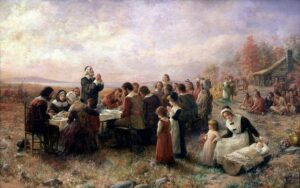
The 51 surviving Mayflower passengers celebrated with the Native Americans following harvest in the fall of 1621.
STONE: The first Thanksgiving. It wasn’t uncommon to have a harvest festival in Europe and possibly for Native Americans to have a celebration of the harvest as well. We know this from one of Edward Winslow’s journals. He says they gathered in their harvest, and they began to celebrate and to give thanks to God for the bounty. And Massasoit and some 90 men came, and they celebrated together. They brought five deer and “exercised their arms,” so they shot bows and arrows and their guns, and they probably played games together. It was a three-day feast that also included fish and fowl as well as some of the harvest. That celebration of the Pilgrims and the Native Americans is the tradition that was handed down to us and became our Thanksgiving.
AWAKEN: Most history studies of the Pilgrims stop at Thanksgiving. What happened to the Pilgrims after that?
STONE: The colony grows, so in 1621, another ship called The Fortune comes. In 1623, The Anne and The Little James come, bringing more people from England but also more members of the Holland congregation over to the New World, so the plantation expanded. As they expand, they purchased land from the Native Americans.
In 1630, the city of Boston is founded by Gov. John Winthrop. Gov. Winthrop gave the famous sermon on Christian charity where he coined the phrase that we shall be the “shining city upon a hill.” So Boston is founded as a Puritan society. After a number of years of trying to purify the Church of England, (the Puritans) decided to come to the New World and establish a state church. The Puritans of Boston and the Pilgrims of Plymouth began to settle in the Massachusetts area. And over the next few decades, there is just more growth. 1630 to 1640 is known as the great migration, where thousands of English people came over to the New World. By 1690, the Plymouth Colony is dissolved into what becomes New England. The Massachusetts Bay Colony is what makes up the modern state of Massachusetts today.
The Roots of Self-Government and the American Revolution
AWAKEN: We really look at the Pilgrims as the forebearers of self-government. Can you speak to that?
STONE: One thing that sort of gives way to America’s distinctive government is the town meeting, where townspeople would gather together; a lot of self-rule comes out of the town meetings. The (concept of) locally elected legislatures is a very big foundational piece for the American Revolution. Some of those self-government ideas that really get fleshed out in the American Revolution have their roots in the history of the Massachusetts colony, which was accustomed to self-rule. By the time we get to the American Revolution, we are talking about anywhere from three to five generations in the colony who were accustomed to governing themselves, which is why when George III tried to restrict their right to self-government, there was such a revolt.
Truth, Sacrifice, and the Importance of Remembering
AWAKEN: History must be passed on to our children. What are the most important things about the Pilgrims that should be taught to our children?
STONE: The narrative of American history that has been espoused over the past 15 to 20 years but especially in recent years and months, is that we have a shameful history. When you think about Native Americans and white Americans specifically, there is plenty there that is really tragic. However, the Pilgrims’ (experience) is not one of those stories. And William Penn is another example of a people who did it the right way. My heart behind what we teach is that it is important to learn about the tragic interchange between Europeans and Native Americans. There are very important lessons to learn there, but there are just as many important lessons to be learned from people like the Pilgrims and the Quakers. They were acting in what we would say is true Christian fashion by treating the Native Americans according to the second great commandment.
STAUFFER: One of the things that we expressed in third grade, of course, is Christian character. These are examples of everyday people. It is today’s church 400 years ago. It is a great example of ordinary men that God used, and God can use you as an ordinary person as well. God uses individuals. Each one of my little kids is an individual that God can someday use, just like William Bradford. I hold them up as those examples of Christian men and women who were able to just act in godliness.
We also talk about the price necessary for liberty. It’s something that was not free. They laid down everything they had, and they had a vision of passing on their faith to future generations, whatever the cost. They looked at themselves as stepping stones. They did it to pass the story on to their children.
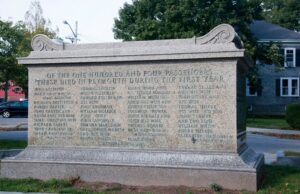
This sarcophagus in Plymouth, Mass., contains the bones of those who died in the first winter in the New World.
We were talking a bit ago about the sarcophagus, where all of the bones of those firstcomers who died that first winter were gathered up. They buried them in the dead of night. And there’s this big tombstone, and there are the names of all the people who are in it written on the side. It is a place we need to go to remember the sacrifices that were given for the price of liberty, so we don’t forget and we don’t quickly relinquish it. These people laid their lives down so that we might walk in freedom and in liberty – that we might govern ourselves according to God’s Word. That we might have that freedom of worship. That we might be able to pass our legacy on to future generations. And we want to look at the future statues and monuments to be reminded that these were individuals like us, and this is the price that they paid so that our future generations can remember and not lose their way.
STONE: Bradford’s tombstone reads, “That which the fathers with such difficulty attained, do not basely relinquish.” In other words, that which your forefathers got through great difficulty, don’t let it go cheaply.
In Jewish and Christian history, God always uses the remnant. It is really easy to feel like we are in the minority when it comes to a culture war. When it comes to religious beliefs. But it is really inspiring to know that God always uses remnants. God uses small entities, individual people, and small movements to keep His story going for His love of His creation.
The Passengers
There were 102 passengers who sailed aboard the Mayflower. Of those, there were 18 adult women, and three of them were at least six months pregnant. They set out upon the stormy seas, knowing that they would give birth either at sea in despairing conditions or in their uncertainty and wilderness of the New World.4 There were three children born on board the Mayflower, though one was stillborn. Fifty-four men and 30 children were also passengers.5 Below are the names of the brave individuals who, for the glory of God and the advancement of the Christian faith, bravely sought passage to freedom aboard the Mayflower. While all had planned to live on and pass their faith and liberty to the next generation, fully half of them did not live beyond that first winter. God used these people to bring a dimly lit light of liberty that was fanned into the full flame of a free nation. Four hundred years later, we remember the Pilgrims who ask from Bradford’s tombstone, “Will what our fathers with so much difficulty attained be relinquished?”
We honor all aboard the Mayflower. Those whose names are in italics did not survive the first winter.
John Alden
Isaac and Mary (Norris) Allerton and children Bartholomew, Remember, and Mary
John Allerton
John and Eleanor Billington and sons John and Francis.
William and Dorothy (May) Bradford
William and Mary Brewster and children Love and Wrestling
Richard Britteridge
Peter Browne
William Butten
Robert Carter
John and Katherine (White) Carver
James and Mrs. Chilton and daughter Mary
Richard Clarke
Francis Cooke and son John
Humility Cooper
John Crackstone and son John
Edward Doty
Francis and Sarah Eaton and son Samuel
Thomas English
Moses Fletcher
Edward and Mrs. Fuller and son Samuel
Samuel Fuller
Richard Gardiner
John Goodman
William Holbeck
John Hooke
Stephen and Elizabeth (Fisher) Hopkins and children Constance, Giles, and Damaris; son Oceanus was born during the voyage.
John Howland
John Langmore
William Latham
Edward Leister
Edmund Margesson
Christopher and Mary (Prower) Martin
Desire Minter
Ellen, Jasper, Richard, and Mary More
William and Alice Mullins and children Priscilla and Joseph
Degory Priest
Solomon Prower
John and Alice Rigsdale
Thomas Rogers and son Joseph
Henry Samson
George Soule
Myles and Rose Standish
Elias Story
Edward Thompson
Edward and Agnes (Cooper) Tilley
John and Joan (Hurst) Tilley and daughter Elizabeth
Thomas and Mrs. Tinker and a son
William Trevore
John Turner and two sons
Richard Warren
William and Susanna (Jackson) White and son Resolved; son Peregrine was born shipboard in Provincetown Harbor after arrival.
Roger Wilder
Thomas Williams
Edward and Elizabeth (Barker) Winslow
Gilbert Winslow
“Mr. Ely”
Dorothy (John Carver’s maidservant)
Study the Pilgrims for Yourself
For further study on the Pilgrims, Stone and Stauffer recommend these resources.
 Of Plymouth Plantation in Modern English is the primary source by William Bradford in today’s English.
Of Plymouth Plantation in Modern English is the primary source by William Bradford in today’s English.
Pilgrim Edward Winslow’s journal is called Mourt’s Relation: A Journal of the Pilgrims at Plymouth, and it is named after the publisher George Morton.
Mayflower: A Story of Courage, Community, and War by Nathaniel Philbrick
Plymouth in the Words of Her Founders by Dr. Paul Jehle
Journey of Faith: Why the Pilgrims Came by Dr. Paul Jehle
Places to visit in Plymouth, Mass.:
National Monument to the Forefathers
Coles Hill Burial Ground
The Jenney Interpretive Centre
While Stone and Stauffer recommend visiting Plimoth Plantation, they are careful to note that while there is good information to be learned, it is not the biblical perspective that was held by the Pilgrims.
 “It is somewhat difficult to find the truth when you go to Plymouth, just like anyplace else. History is beginning to be erased or rewritten. There is an agenda there, like in so many other places. It is important to have a book that tells you from Bradford’s perspective, so you can really get the truth of what happened in Plymouth. Take some good resources with you when you go,” Stauffer said.
“It is somewhat difficult to find the truth when you go to Plymouth, just like anyplace else. History is beginning to be erased or rewritten. There is an agenda there, like in so many other places. It is important to have a book that tells you from Bradford’s perspective, so you can really get the truth of what happened in Plymouth. Take some good resources with you when you go,” Stauffer said.
At Dayspring Christian Academy, students are taught Providential history, the view that God is actively involved in every aspect of life, telling His story throughout history for His plans and purposes. Consequently, students learn the rudiments of America’s Christian history, from the time of the Pilgrims to its founding up to current times. Thinking and reasoning from God’s Word enable students to identify Truth and stand firm in their faith. Dayspring students delve deeply into the timeline of Christian history and arrive at the question, “How will God use me in His story?” To learn more, take a tour. Register online or call Karol Hasting at 717-285-2000.
Works Cited:
1 Jehle, Dr. Paul. Journey of Faith: Why the Pilgrims Came. Plymouth Plantation, Inc., 2020.
2Ibid.
3Bradford, William. Of Plymouth Plantation. Enhanced Media Publishing, 2018.
4https://www.mayflower400uk.org/education/women-of-the-mayflower/
5https://www.mayflower400uk.org/education/who-were-the-pilgrims/2019/august/children-of-the-mayflower
6http://mayflowerhistory.com/mayflower-passenger-list
This story originally appeared in the 2021 edition of Awaken Magazine. You can download a digital copy or fill out our Contact Us form to receive a physical copy.
